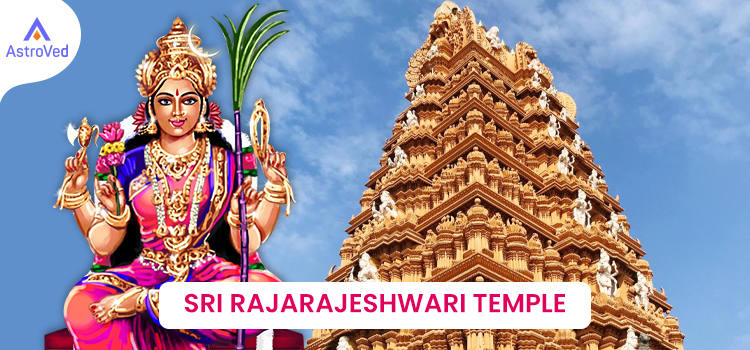Nanganallur is a southern neighborhood in Chennai, Tamil Nadu. The area is home to many renowned temples, some of which are quite ancient, too. They include the Dharmalingeshwarar Temple, Ardhanareeshwarar Temple, Vembuli Amman temple, Adivyathihara Bhakthanjaneya temple, Raja Rajeshwari temple, Uthira Guruvayurappan temple, Lakshmi Narasimha temple, Karumariamman temple, Ragavendra temple, Lakshmi Hayagrivar temple, Ayyappan Temple, Sri Sakthi Vinayagar Temple, etc. Sri Rajarajeswari temple is one of the oldest temples here, and the area got its name from the Goddess. ‘Nanga Nallai’ means ‘place of good-natured women,’ and it later became Nanganallur. This is a private temple and is also known as Sarvamangala Rajarajeswari Ashram. The temple has two floors and is located on 16th street at Thillaiganga Nagar.
The presiding deity here is Goddess Rajarajeshwari, an incarnation of Goddess Shakti. Her idol supposedly came from the Homa Kundam. This temple is quite unique, as devotees should circumambulate it only in the anti-clockwise direction, unlike in other temples.
Sri Rajarajeshwari Temple was built in the early 1970s by Sri Rajarajeswari Ashram under the guidance of Sri Rajagopala Swamigal. Worshipping Goddess Rajarajeswari here on Tuesdays will cure all ailments, goes the belief. Worshipping here on Fridays can bring prosperity. Purnima (Full Moon day) is also very auspicious for worshipping the Goddess.
Legend behind the Temple
According to legend, Ambal forced Sri Rajagopala Swamigal to construct a temple after resigning from his bank job. All the contributions came from his disciples. The idol was shifted to the current location in 1970 (an Ambal temple supposedly existed since ancient times at the same place where a new temple was built). The temple was built not as per Agama. The Poojas are conducted as per Sri Vidya tradition. Sri Rajagopala Swamigal trained his disciples to perform the Pooja. The belief is that Agasthiyar and Thirumoolar worshipped this Ambal when the old temple existed.
The main deity of this temple emerged in a Homa kundam. Rajagopala Swamigal, the founder of Rajarajeswari temple, was performing homam to the Goddess on Navarathri Friday, on Vishaka Nakshatra in 1957, in a mini yagasala atop his house in George Town, Chennai. Hundreds of devotees were at the house to seek the blessings of the goddess. The Swamigal completed Poornahuti and gave Prasadam to everyone. Suddenly, one of his aides emerged from the Pooja room and pointed to some stones glinting in the agni of the Homa kundam.
Swamigal tried to collect the stones from the Homa kundam on a tray. The stones felt very heavy, and the tray tilted to one side, unable to bear the weight. The next day the Swamigal showed the stones to Kanchi Paramacharya. The latter promptly identified the big stone as Ambal and the other small stones as Siddhi Manigal.
Within a year, the big stone was sculpted in the form of Goddess Rajarajeswari holding a Shankh (conch), Chakram (discus), sugarcane bow and pushpa baanam (flower arrows). Rajagopala Swamigal, by divine instruction, built the temple and ashram in Thillai Ganga Nagar, Nanganallur. He then consecrated the idol of Goddess Rajarajeswari, which is the presiding deity.
Architecture of the Temple
There are 43 Yantras of Shakti deities installed in the temple. Sixteen steps lead to the sanctum sanctorum, and each has its own significance. At the entrance of the steps, Sanganidhi and Padmanidhi bless devotees.
The temple faces east, with an entrance from the north. The temple resembles a big house. At the entrance Prakara, one can see the idols of Ashtadikpalakas. One can see the shrines for Dattatreya and Bhairavar immediately after the entrance on both sides. The main sanctum is at an elevation. To reach the main shrine, one has to circumambulate from left to right after worshiping Ganesha and Durga.
On the ground floor is the temple for Sri Lakshmisametha Satyanarayana Swamy. Here, the Lakshmi’s image is on the chest of Perumal. Devotees perform Satyanarayana Vratham here. Unlike in other Vishnu temples, one can see the Navagrahas on the wall in a straight line. The devotees go around the temple in the anti-clockwise direction. First, they receive the darshan of Vinayaka and Durga. Later, they get the darshan of the Goddess, who is on the second floor.
The Goddess is installed on Mahameru with Yantras. The special Pooja here is the Kunguma Pooja. Devotees get the Kunmkum (vermilion) along with Archana and they deposit it in the Box along with their name, birth star, Thithi, and Tithi Nithya. They can buy the Archana Kumkum only in the temple.
The Dhwajasthambam and Simha vahanam are seen before the entrance of the main sanctum steps. There are 16 steps on the Purva paksha (ascending side) and 16 steps on the Amara paksha (descending side). While descending, we can see 15 stucco idols of Thithi Devatas (representing 15 lunar phases and 15 letters of Mahashodasi Mantra) on the wall, with Agasthya Muni’s hymn engraved below each idol.
Goddess Rajarajeswari is seen in a sitting posture on the Meru Yantra, holding a discus, conch, sugarcane bow, and flower arrows in her four arms. Covered in beautiful ornaments, she looks resplendent in the glow of oil lamps. Lakshmi and Saraswati flank her on one side, and Ganesha and Murugan on the other side. Subshrines of Matangi and Varahi are on either side of the sanctum. There are 51 Shakti Yantras in this temple, which makes this place equivalent to fifty-one Shakti Peethas in India.
There are shrines for Dattratreya, Bhairava, Ganesha, Dhanvantri, and Durga inside the temple complex. Stucco images that depict the female forms of deities like Brahma, Vishnu, Shiva, Indra, and Kartikeya adorn the entrance of the temple. There are many other stucco images, too, which make the temple appear colorful and vibrant.
Varuna Dhanvantari Theertham is a well within temple premises. The water from this well can supposedly cure diseases. The rays from the sun fall on the Goddess’ feet during Maasi and Magha months. Special poojas are held at this time.
How to Reach
By Air
The temple is 4 km from Meenambakkam Airport and 7 km from Chennai International Airport. One can get a cab to the temple from here.
By Train
Pazhavanthangal is the nearest railway station and is 1 km away. One can get an auto to the temple.
By Road
The temple is 13 km from the Tambaram bus stand and 14 km from the Koyambedu bus terminus. It is well connected by MTC buses to other parts of Chennai.
Temple Timings
6 am to 11 am and 5:30 pm to 8:30 pm


